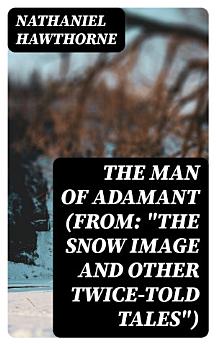The Man of Adamant (From: "The Snow Image and Other Twice-Told Tales")
Aug 2022 · DigiCat
Ebook
8
Pages
family_home
Eligible
info
reportRatings and reviews aren’t verified Learn More
About this ebook
In 'The Man of Adamant,' Nathaniel Hawthorne captivates readers with an allegorical tale that explores the rigid dogmatism of its protagonist, a hermit named Richard Digby. This story is among the rich collection in 'The Snow Image and Other Twice-Told Tales,' wherein Hawthorne's mastery of symbolism intertwines with the gothic romance tradition. The narrative, dense with Hawthorne's characteristic dark romanticism, challenges the moralistic rigidity of 19th-century Puritanism, contrasting inflexible piety with the transformative power of nature and human connection. Its literary style is reflective of Hawthorne's broader corpus, where narrative intricacy and profound character introspection take center stage. Nathaniel Hawthorne, a luminary of American literature, brings his acute understanding of the puritanical psyche and deep New England roots to 'The Man of Adamant.' Hawthorne's own ancestral history, interwoven with the Puritan experience and its subsequent guilt, informs his writing, offering a critical examination of isolation and the peril of unyielding righteousness. His insight into the human condition and its complexities allows for a story that is as poignant today as it was in Hawthorne's time. Readers of classic American literature and enthusiasts of allegorical tales will find 'The Man of Adamant' an essential read. The story not only showcases Hawthorne's literary prowess but also serves as a timeless reflection on the dangers of intolerance and the necessity of empathy. As a part of DigiCat Publishing's dedication to preserving such significant works, this story is presented with the care it merits, securing its place in the canon of important world literature and providing a meaningful experience to contemporary readers.
About the author
Nathaniel Hawthorne (1804-1864) remains a towering figure in American literature, celebrated for his keen psychological insight and his articulate portrayal of the human condition. With a career that spanned the tumultuous antebellum period, Hawthorne is best known for his richly symbolic and dark romantic storytelling. His mastery of allegory and symbolism is exemplified in his collection 'The Snow Image and Other Twice-Told Tales', which includes the story 'The Man of Adamant.' His works often explore themes of sin, guilt, and redemption, deeply rooted in the Puritanical ethos of New England, about which he wrote with both critical insight and nuanced sympathy. Hawthorne's 1850 novel 'The Scarlet Letter' is considered his magnum opus, depicting the harsh consequences of sin in a rigid Puritan society and remains a staple in American literature curricula. His other notable works include 'The House of the Seven Gables' (1851), which like his other writings, reflects on the complexities of moral choices and the pervasive influence of history on present-day life. Hawthorne's literary style is characterized by a somber elegance, a disciplined use of irony, and a profound empathy for his characters' inner conflicts. His contributions to American letters have made him a central figure in the American Romantic movement, and his works continue to be studied and admired for their narrative complexity and psychological depth.
Rate this ebook
Tell us what you think.
Reading information
Smartphones and tablets
Install the Google Play Books app for Android and iPad/iPhone. It syncs automatically with your account and allows you to read online or offline wherever you are.
Laptops and computers
You can listen to audiobooks purchased on Google Play using your computer's web browser.
eReaders and other devices
To read on e-ink devices like Kobo eReaders, you'll need to download a file and transfer it to your device. Follow the detailed Help Center instructions to transfer the files to supported eReaders.








